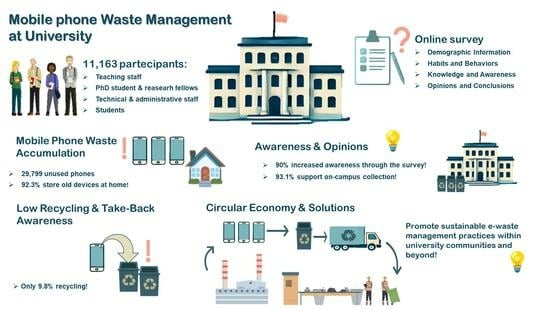Sustainable Mobile Phone Waste Management: Behavioral Insights and Educational Interventions Through a University-Wide Survey
Abstract
1. Introduction
1.1. The Growing Challenge of Mobile Phone Waste: Environmental, Economic and Policy Perspectives
1.2. Universities as Key Drivers in Promoting Sustainable E-Waste Management: The Survey as an Educational Tool
1.3. The Structure of the Paper
2. Results and Discussion
2.1. General Information (GI)
2.2. Habits and Behaviors (HBs) Towards EOL Mobile Phone Management
2.2.1. Mobile Phone Ownership and Replacement Frequency
2.2.2. Reasons for Mobile Phone Replacement and Technical Conditions
2.2.3. Handling and Disposal of Unused Mobile Phones
2.2.4. Stockpiled Discarded Mobile Phones at Home: Estimation of Recoverable Precious and Critical Raw Materials
2.3. Knowledge and Awareness (KA) About EOL Mobile Phone Management
2.3.1. Hazardous Elements in Mobile Phones and the Risks of Improper Disposal
2.3.2. Precious and Rare Metals in Mobile Phones
2.3.3. Critical and Strategic Raw Materials in Mobile Phones
2.3.4. WEEE Take-Back Programs
2.4. Opinions and Conclusions (OCs)
2.4.1. Reasons for the Importance of WEEE Separate Collection: Respondents’ Perceptions
2.4.2. Self-Assessment of Knowledge and Responsibility in WEEE Management
2.4.3. The Survey as an Educational Tool: Impact on Awareness and Knowledge Sharing
2.4.4. Potential for a University-Based Small WEEE Collection System: Willingness to Participate
3. Methods
3.1. Survey Design and Distribution
3.2. Data Aggregation and Analysis
4. Conclusions and Future Perspectives
Supplementary Materials
Author Contributions
Funding
Data Availability Statement
Acknowledgments
Conflicts of Interest
References
- Appolloni, A.; Chiappetta Jabbour, C.J.; D’Adamo, I.; Gastaldi, M.; Settembre-Blundo, D. Green recovery in the mature manufacturing industry: The role of the green-circular premium and sustainability certification in innovative efforts. Ecol. Econ. 2022, 193, 107311. [Google Scholar] [CrossRef]
- I.T.U. Measuring Digital Development: Facts and Figures; ITU: Geneva, Switzerland, 2024; pp. 1–42. [Google Scholar]
- Aboelmaged, M. E-waste recycling behaviour: An integration of recycling habits into the theory of planned behaviour. J. Clean. Prod. 2021, 278, 124182. [Google Scholar] [CrossRef]
- Tutton, C.G.; Young, S.B.; Habib, K. Pre-processing of e-waste in Canada: Case of a facility responding to changing material composition. Resour. Environ. Sustain. 2022, 9, 100069. [Google Scholar] [CrossRef]
- Baldé, C.P.; Kuehr, R.; Yamamoto, T.; McDonald, R.; Althaf, S.; Bel, G.; Deubzer, O.; Fernandez-Cubillo, E.; Forti, V.; Gray, V.; et al. The Global E-Waste Monitor 2024; International Telecommunication Union (ITU) and United Nations Institute for Training and Research (UNITAR): Geneva, Switzerland, 2024. [Google Scholar]
- Romagnoli, V.; de Bruijne, E.; Drapeau, P.; Ollion, L.; Anaëlle, C. Study on Options for Return Schemes of Mobile Phones, Tablets and Other Small Electrical and Electronic Equipment in the EU; Publications Office of the European Union: Luxembourg, 2022. [Google Scholar]
- Colasante, A.; D’Adamo, I.; Morone, P.; Rosa, P. Assessing the circularity performance in a European cross-country comparison. Environ. Impact Assess. Rev. 2022, 93, 106730. [Google Scholar] [CrossRef]
- Jabbour, C.J.C.; Colasante, A.; D’Adamo, I.; Rosa, P.; Sassanelli, C. Comprehending e-waste limited collection and recycling issues in Europe: A comparison of causes. J. Clean. Prod. 2023, 427, 139257. [Google Scholar] [CrossRef]
- Arain, A.; Pummill, R.; Adu-Brimpong, J.; Becker, S.; Green, M.; Ilardi, M.; Van Dam, E.; Neitzel, R. Analysis of e-waste recycling behavior based on survey at a Midwestern US University. Waste Manag. 2020, 105, 119–127. [Google Scholar] [CrossRef]
- Wang, F.; Huisman, J.; Meskers, C.E.M.; Schluep, M.; Stevels, A.; Hagelüken, C. The Best-of-2-Worlds philosophy: Developing local dismantling and global infrastructure network for sustainable e-waste treatment in emerging economies. Waste Manag. 2012, 32, 2134–2146. [Google Scholar] [CrossRef] [PubMed]
- Zhang, Y.; Wu, S.; Rasheed, M.I. Conscientiousness and smartphone recycling intention: The moderating effect of risk perception. Waste Manag. 2020, 101, 116–125. [Google Scholar] [CrossRef]
- Cheshmeh, Z.A.; Bigverdi, Z.; Eqbalpour, M.; Kowsari, E.; Ramakrishna, S.; Gheibi, M. A comprehensive review of used electrical and electronic equipment management with a focus on the circular economy-based policy-making. J. Clean. Prod. 2023, 389, 136132. [Google Scholar] [CrossRef]
- Grohol, M.; Veeh, C. Study on the Critical Raw Materials for the EU 2023—Final Report; Directorate General for Internal Market, Industry, Entrepreneurship and SMEs; European Commission: Brussels, Belgium, 2023. [Google Scholar]
- Chakraborty, S.C.; Qamruzzaman, M.; Zaman, M.W.U.; Alam, M.M.; Hossain, M.D.; Pramanik, B.K.; Nguyen, L.N.; Nghiem, L.D.; Ahmed, M.F.; Zhou, J.L.; et al. Metals in e-waste: Occurrence, fate, impacts and remediation technologies. Process Saf. Environ. Prot. 2022, 162, 230–252. [Google Scholar] [CrossRef]
- Dhir, A.; Malodia, S.; Awan, U.; Sakashita, M.; Kaur, P. Extended valence theory perspective on consumers’e-waste recycling intentions in Japan. J. Clean. Prod. 2021, 312, 127443. [Google Scholar] [CrossRef]
- Debnath, B.; Das, A.; Das, S. Studies on Security Threats in Waste Mobile Phone Recycling Supply Chain in India. In Proceedings of the 2020 IEEE Calcutta Conference (CALCON), Kolkata, India, 28–29 February 2020. [Google Scholar]
- Bai, H.; Wang, J.; Zeng, A.Z. Exploring Chinese consumers’ attitude and behavior toward smartphone recycling. J. Clean. Prod. 2018, 188, 227–236. [Google Scholar] [CrossRef]
- Parajuly, K.; Fitzpatrick, C.; Muldoon, O.; Kuehr, R. Behavioral change for the circular economy: A review with focus on electronic waste management in the EU. Resour. Conserv. Recycl. X 2020, 6, 100035. [Google Scholar] [CrossRef]
- Jabbour, C.J.C.; Colasante, A.; D’Adamo, I.; Rosa, P.; Sassanelli, C. Customer attitudes toward circular economy in the E-waste context: A survey assessing sustainable consumption dynamics. IEEE Eng. Manag. Rev. 2023, 51, 28–45. [Google Scholar] [CrossRef]
- Koshta, N.; Patra, S.; Singh, S.P. Sharing economic responsibility: Assessing end user’s willingness to support E-waste reverse logistics for circular economy. J. Clean. Prod. 2022, 332, 130057. [Google Scholar] [CrossRef]
- Corsini, F.; Gusmerotti, N.M.; Frey, M. Consumer’s circular behaviors in relation to the purchase, extension of life, and end of life management of electrical and electronic products: A review. Sustainability 2020, 12, 10443. [Google Scholar] [CrossRef]
- Islam, M.T.; Huda, N. Reshaping WEEE management in Australia: An investigation on the untapped WEEE products. J. Clean. Prod. 2020, 250, 119496. [Google Scholar]
- Thukral, S.; Shree, D.; Singhal, S. Consumer behaviour towards storage, disposal and recycling of e-waste: Systematic review and future research prospects. Benchmarking Int. J. 2023, 30, 1021–1072. [Google Scholar]
- Islam, M.T.; Dias, P.; Huda, N. Waste mobile phones: A survey and analysis of the awareness, consumption and disposal behavior of consumers in Australia. J. Environ. Manag. 2020, 275, 111111. [Google Scholar] [CrossRef] [PubMed]
- Liu, J.; Bai, H.; Zhang, Q.; Jing, Q.; Xu, H. Why are obsolete mobile phones difficult to recycle in China? Resour. Conserv. Recycl. 2019, 141, 200–210. [Google Scholar] [CrossRef]
- Yin, J.; Gao, Y.; Xu, H. Survey and analysis of consumers’ behaviour of waste mobile phone recycling in China. J. Clean. Prod. 2014, 65, 517–525. [Google Scholar] [CrossRef]
- Subhaprada, C.S.; Kalyani, P. Study on awareness of e-waste management among medical students. Int. J. Community Med. Public Health 2017, 4, 506–510. [Google Scholar] [CrossRef]
- Boiocchi, R.; Adami, L.; Rada, E.C.; Schiavon, M. Towards context-independent indicators for an unbiased assessment of environmental sustainability in higher education: An application to Italian universities. J. Environ. Manag. 2024, 366, 121658. [Google Scholar] [CrossRef] [PubMed]
- Prabhu, N.S.; Majhi, R. Disposal of obsolete mobile phones: A review on replacement, disposal methods, in-use lifespan, reuse and recycling. Waste Manag. Res. 2023, 41, 18–36. [Google Scholar] [CrossRef] [PubMed]
- Martinho, G.; Magalhães, D.; Pires, A. Consumer behavior with respect to the consumption and recycling of smartphones and tablets: An exploratory study in Portugal. J. Clean. Prod. 2017, 156, 147–158. [Google Scholar] [CrossRef]
- Cordella, M.; Alfieri, F.; Clemm, C.; Berwald, A. Durability of smartphones: A technical analysis of reliability and repairability aspects. J. Clean. Prod. 2021, 286, 125388. [Google Scholar] [CrossRef]
- Gómez, M.; Grimes, S.; Qian, Y.; Feng, Y.; Fowler, G. Critical and strategic metals in mobile phones: A detailed characterisation of multigenerational waste mobile phones and the economic drivers for recovery of metal value. J. Clean. Prod. 2023, 419, 138099. [Google Scholar] [CrossRef]
- Tansel, B. From electronic consumer products to e-wastes: Global outlook, waste quantities, recycling challenges. Environ. Int. 2017, 98, 35–45. [Google Scholar] [CrossRef]
- Vats, M.; Singh, S. Assessment of gold and silver in assorted mobile phone printed circuit boards (PCBs). Waste Manag. 2015, 45, 280–288. [Google Scholar] [CrossRef]
- Oraee, A.; Pohl, L.; Geurts, D.; Reichel, M. Overcoming premature smartphone obsolescence amongst young adults. Clean. Responsible Consum. 2024, 12, 100174. [Google Scholar]
- Calafell, G.; Banqué, N.; Viciana, S. Purchase and Use of New Technologies among Young People: Guidelines for Sustainable Consumption Education. Sustainability 2019, 11, 1541. [Google Scholar] [CrossRef]
- Li, A.; Li, B.; Liu, X.; Zhang, Y.; Zhang, H.; Lei, X.; Hou, S.; Lu, B. Characteristics and dynamics of university students’ awareness of retired mobile phones in China. Sustainability 2022, 14, 10587. [Google Scholar] [CrossRef]
- Zhang, L.; Ran, W.; Jiang, S.; Wu, H.; Yuan, Z. Understanding consumers’ behavior intention of recycling mobile phone through formal channels in China: The effect of privacy concern. Resour. Environ. Sustain. 2021, 5, 100027. [Google Scholar] [CrossRef]
- Palmieri, R.; Bonifazi, G.; Serranti, S. Recycling-oriented characterization of plastic frames and printed circuit boards from mobile phones by electronic and chemical imaging. Waste Manag. 2014, 34, 2120–2130. [Google Scholar] [CrossRef]
- Ongondo, F.; Williams, I. Mobile phone collection, reuse and recycling in the UK. Waste Manag. 2011, 31, 1307–1315. [Google Scholar] [CrossRef]
- Hagelüken, C.; Corti, C.W. Recycling of gold from electronics: Cost-effective use through ‘Design for Recycling’. Gold Bull. 2010, 43, 209–220. [Google Scholar] [CrossRef]
- Ragonnaud, G. Critical Raw Materials Act; EPRS, European Parliament: Bruxelles, Belgium, 2023.
- Ylä-Mella, J.; Keiski, R.L.; Pongrácz, E. Electronic waste recovery in Finland: Consumers’ perceptions towards recycling and re-use of mobile phones. Waste Manag. 2015, 45, 374–384. [Google Scholar] [CrossRef]
- Borthakur, A.; Govind, M. Computer and mobile phone waste in urban India: An analysis from the perspectives of public perception, consumption and disposal behaviour. J. Environ. Plan. Manag. 2019, 62, 717–740. [Google Scholar] [CrossRef]
- Saphores, J.-D.M.; Ogunseitan, O.A.; Shapiro, A.A. Willingness to engage in a pro-environmental behavior: An analysis of e-waste recycling based on a national survey of US households. Resour. Conserv. Recycl. 2012, 60, 49–63. [Google Scholar] [CrossRef]
- Sochnikoff, I.; Lange, F. How to promote mobile phone recovery? Evaluation of a collection campaign in Belgian schools. Clean. Responsible Consum. 2024, 15, 100231. [Google Scholar] [CrossRef]
- Montgomery, D.C.; Runger, G.C.; Hubele, N.F. Engineering Statistics; John Wiley & Sons: Hoboken, NJ, USA, 2009. [Google Scholar]
- Kendall, M.G. The Advanced Theory of Statistics, 2nd ed.; Oxford University Press: Oxford, UK, 1946. [Google Scholar]
- Pinto, F.S.; Simões, P.; Marques, R.C. Raising the bar: The role of governance in performance assessments. Util. Policy 2017, 49, 38–47. [Google Scholar] [CrossRef]
- Novais, A.F.; Tavares, A.F. Governance models and performance in municipal solid waste management: Evidence from local authorities. J. Environ. Manag. 2025, 386, 125829. [Google Scholar] [CrossRef] [PubMed]
- Cucchiella, F.; D’Adamo, I.; Koh, S.L.; Rosa, P. Recycling of WEEEs: An economic assessment of present and future e-waste streams. Renew. Sustain. Energy Rev. 2015, 51, 263–272. [Google Scholar] [CrossRef]
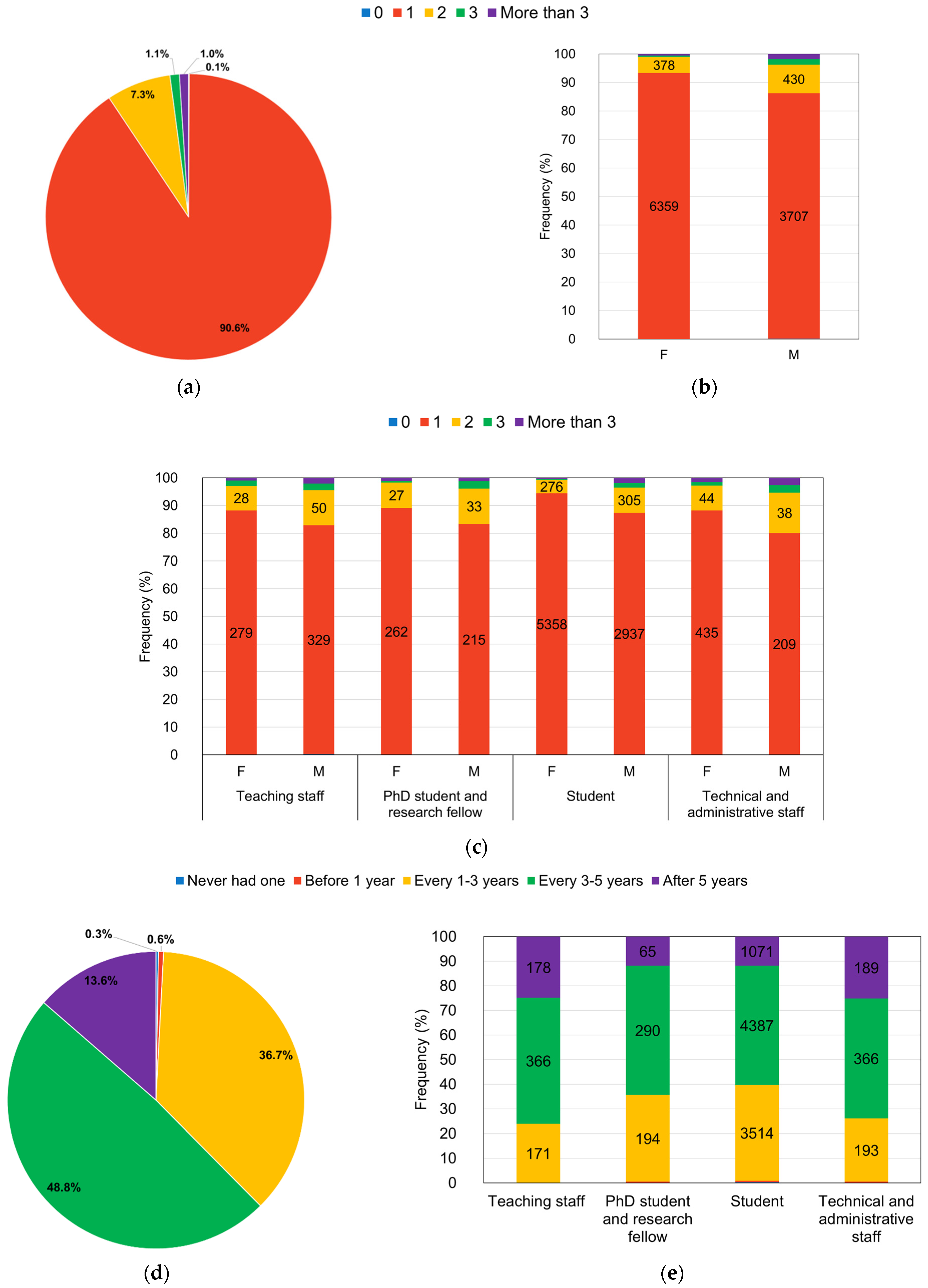
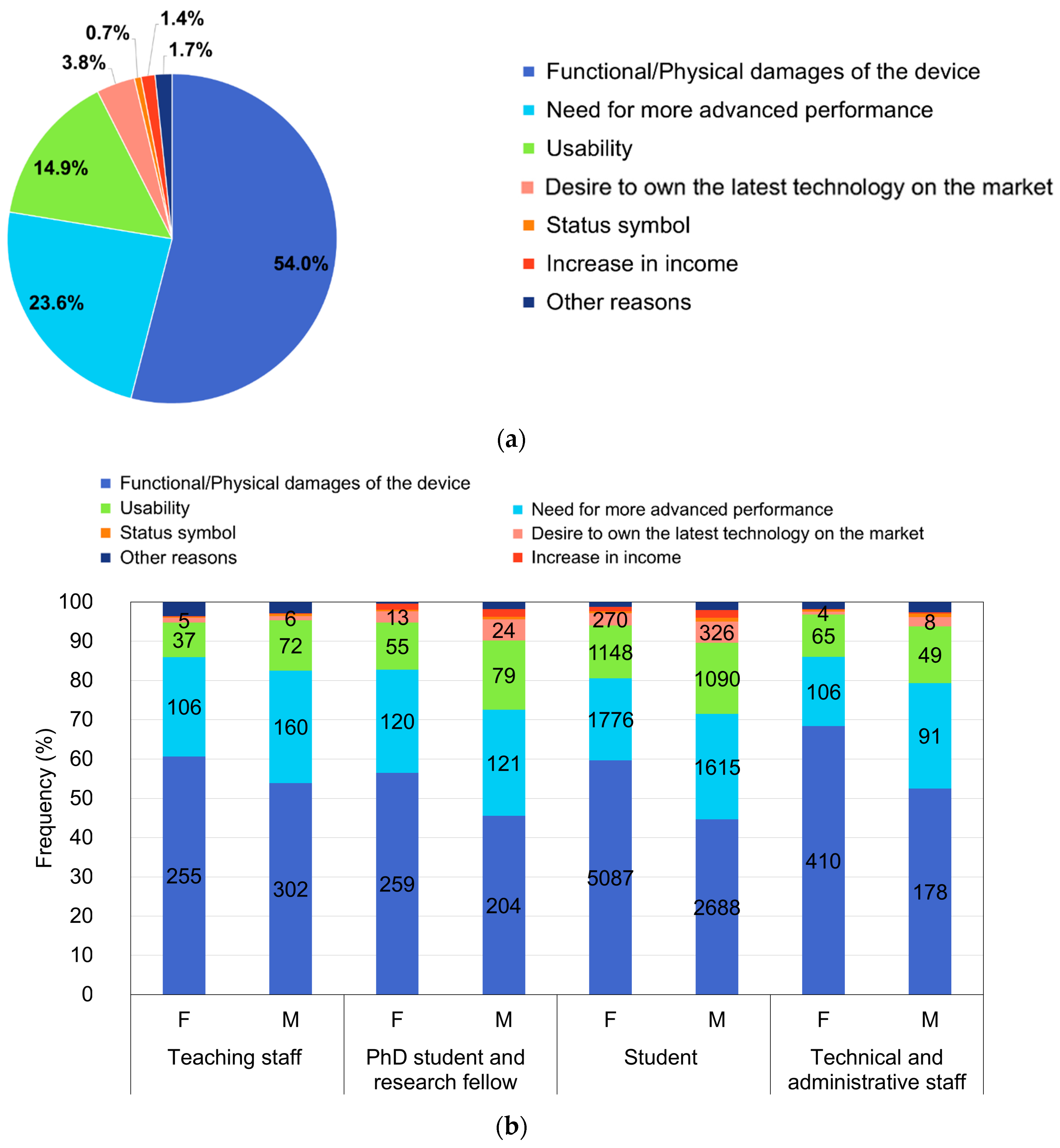
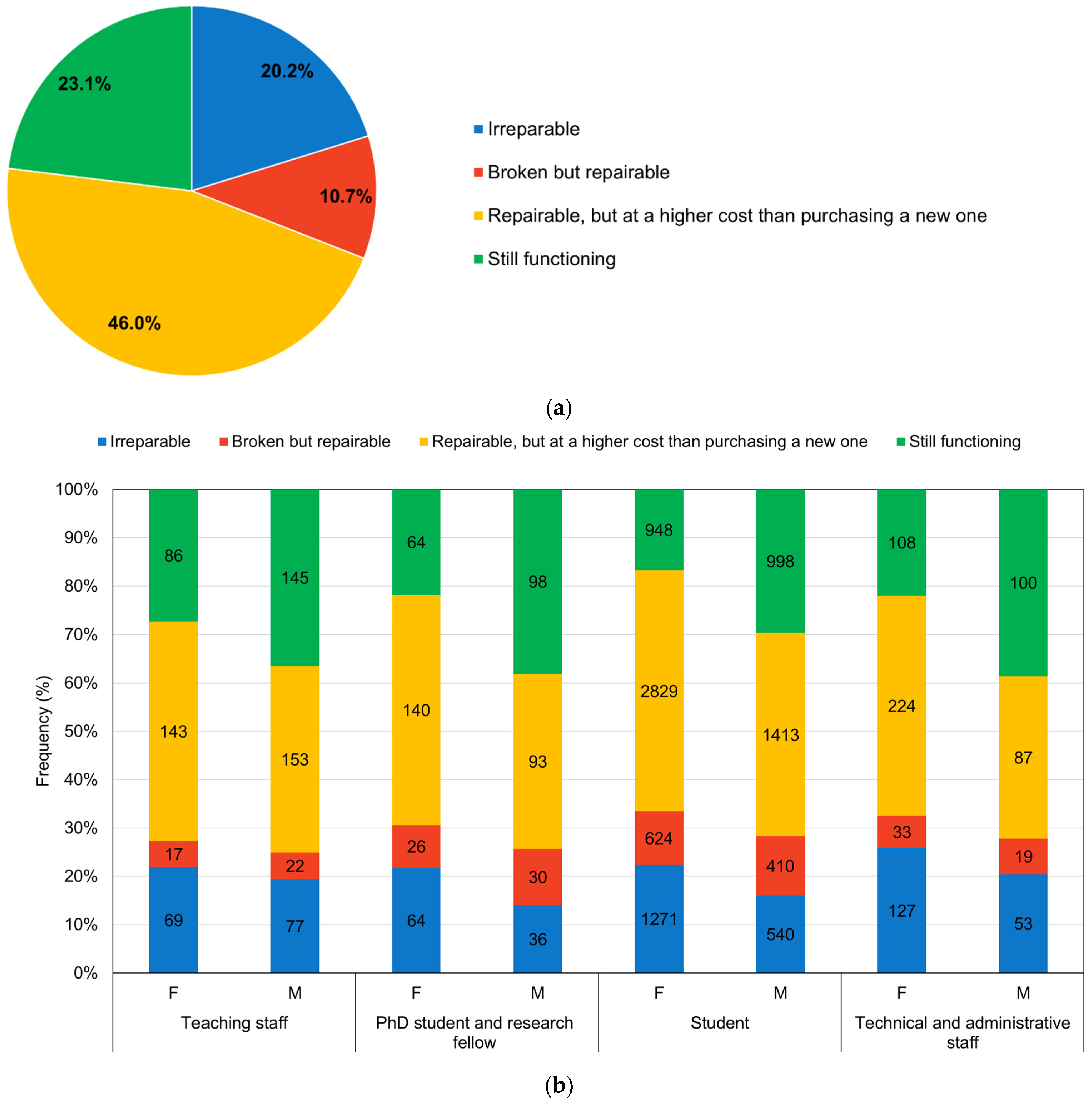
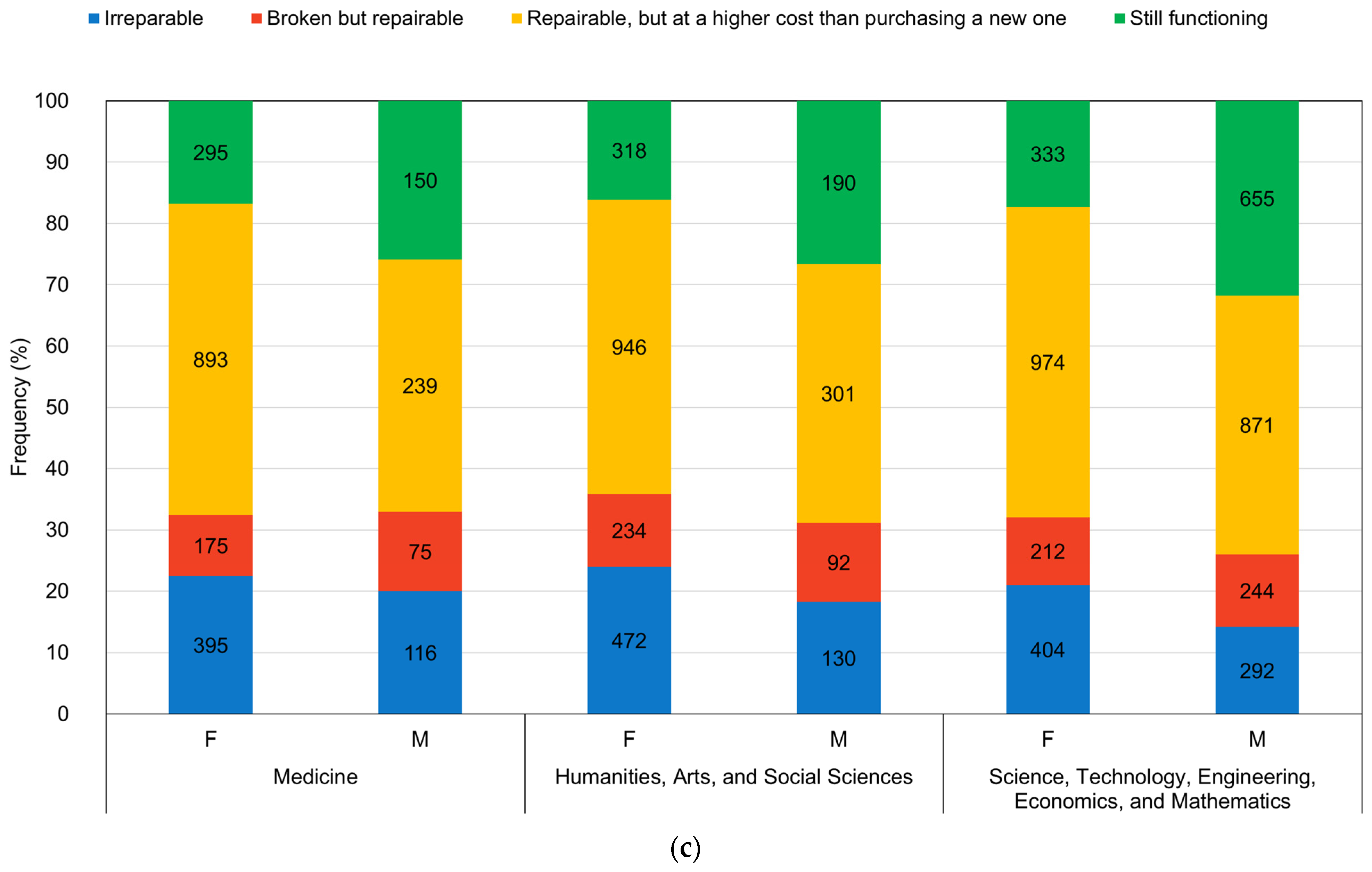
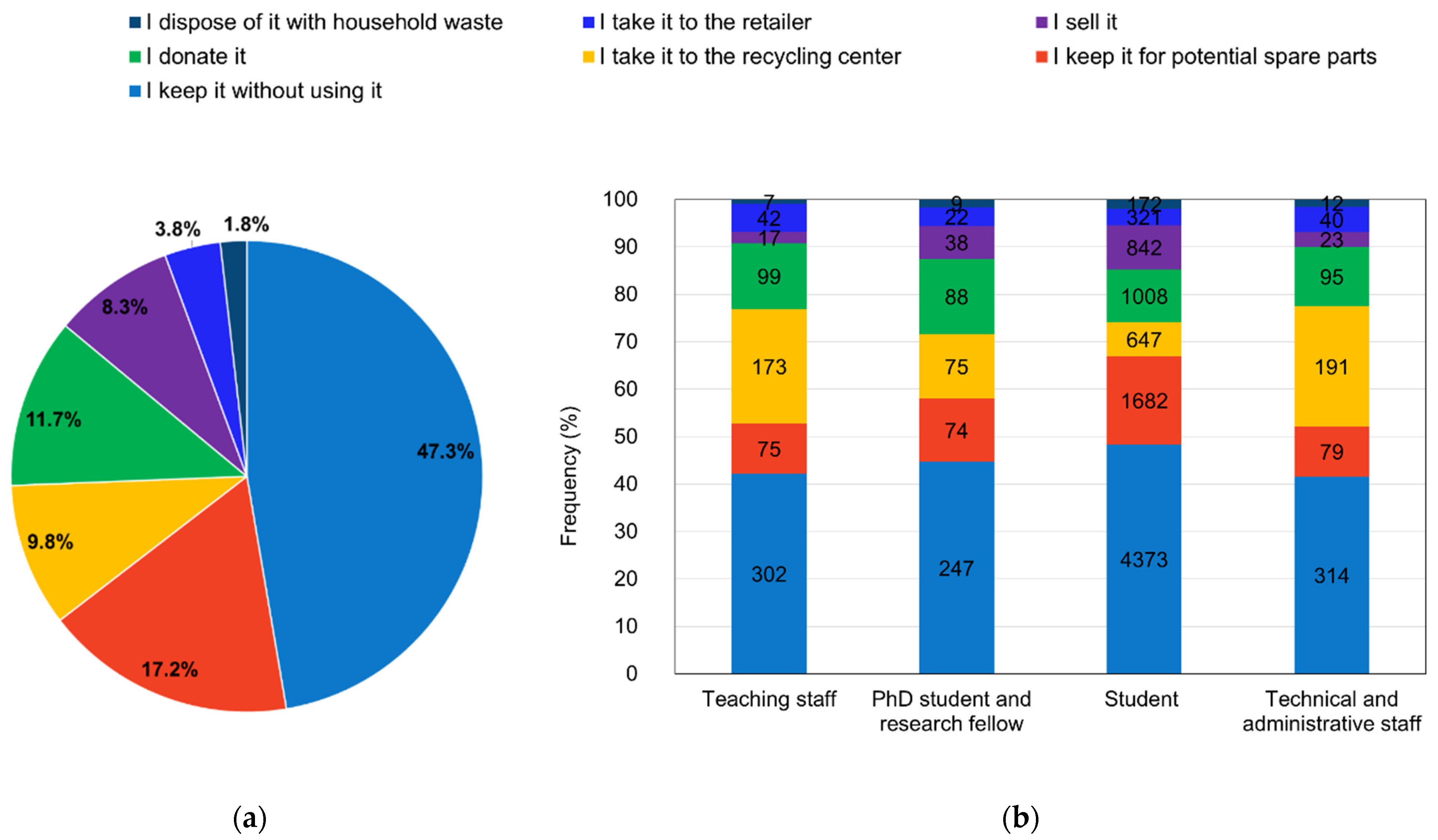
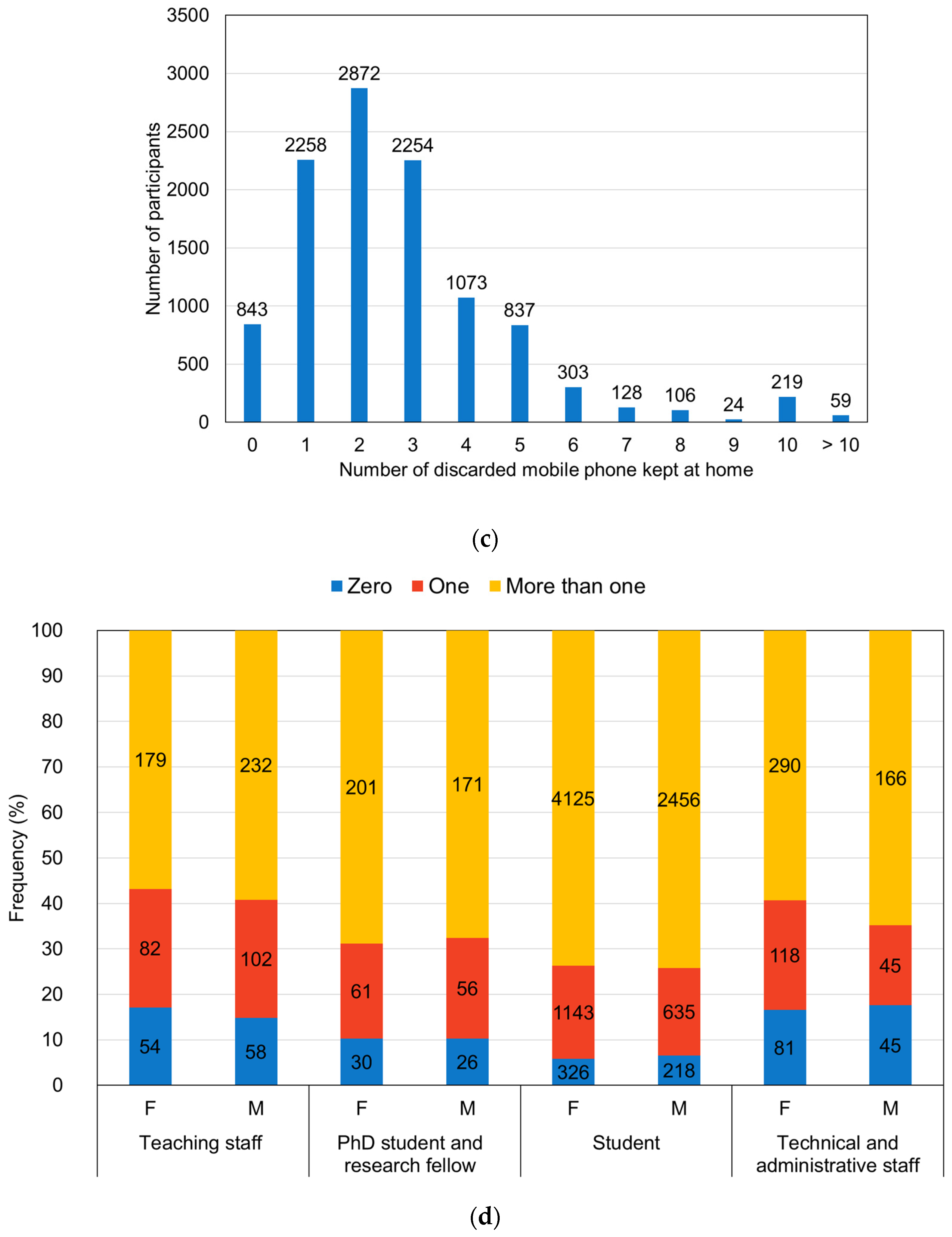

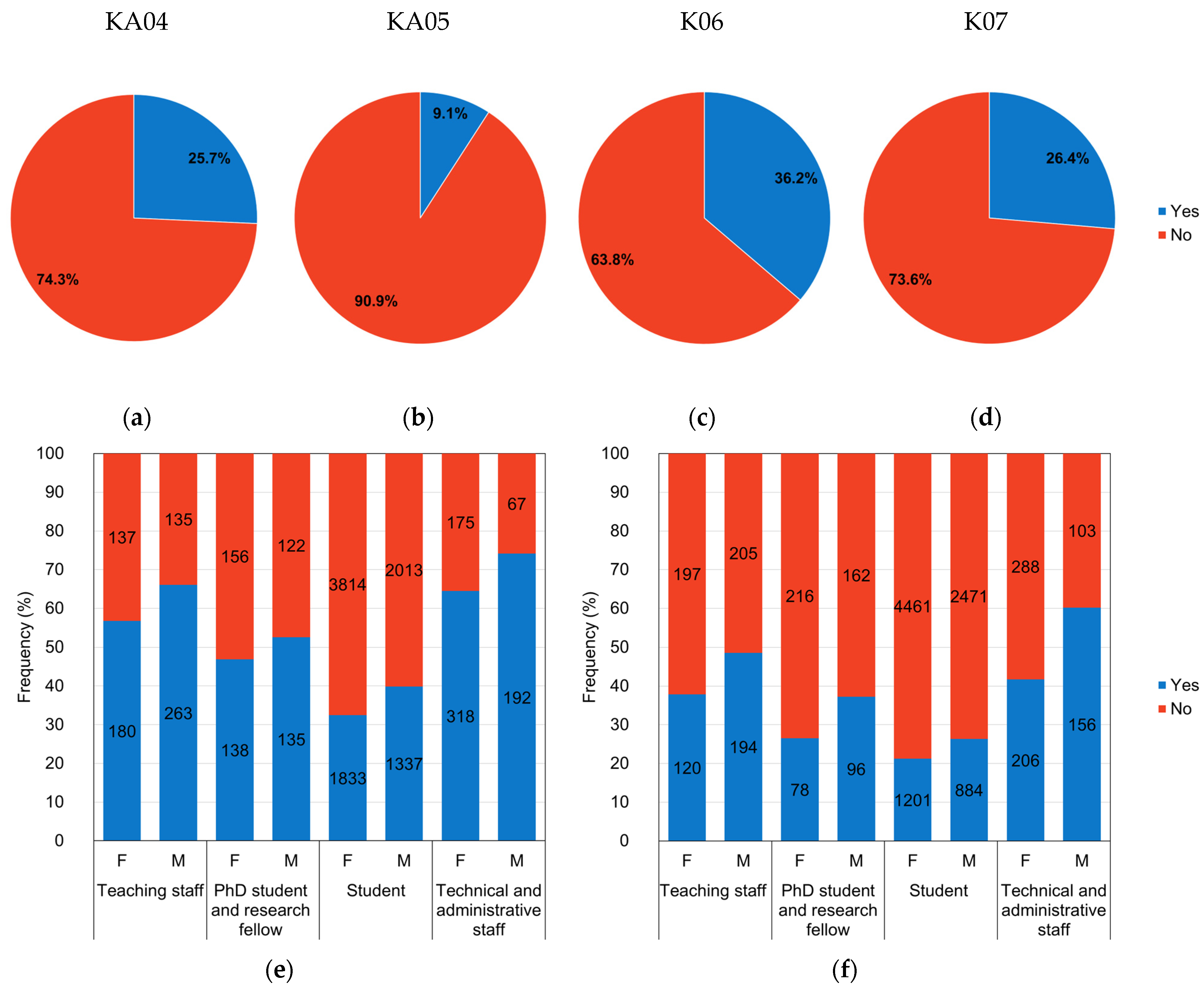
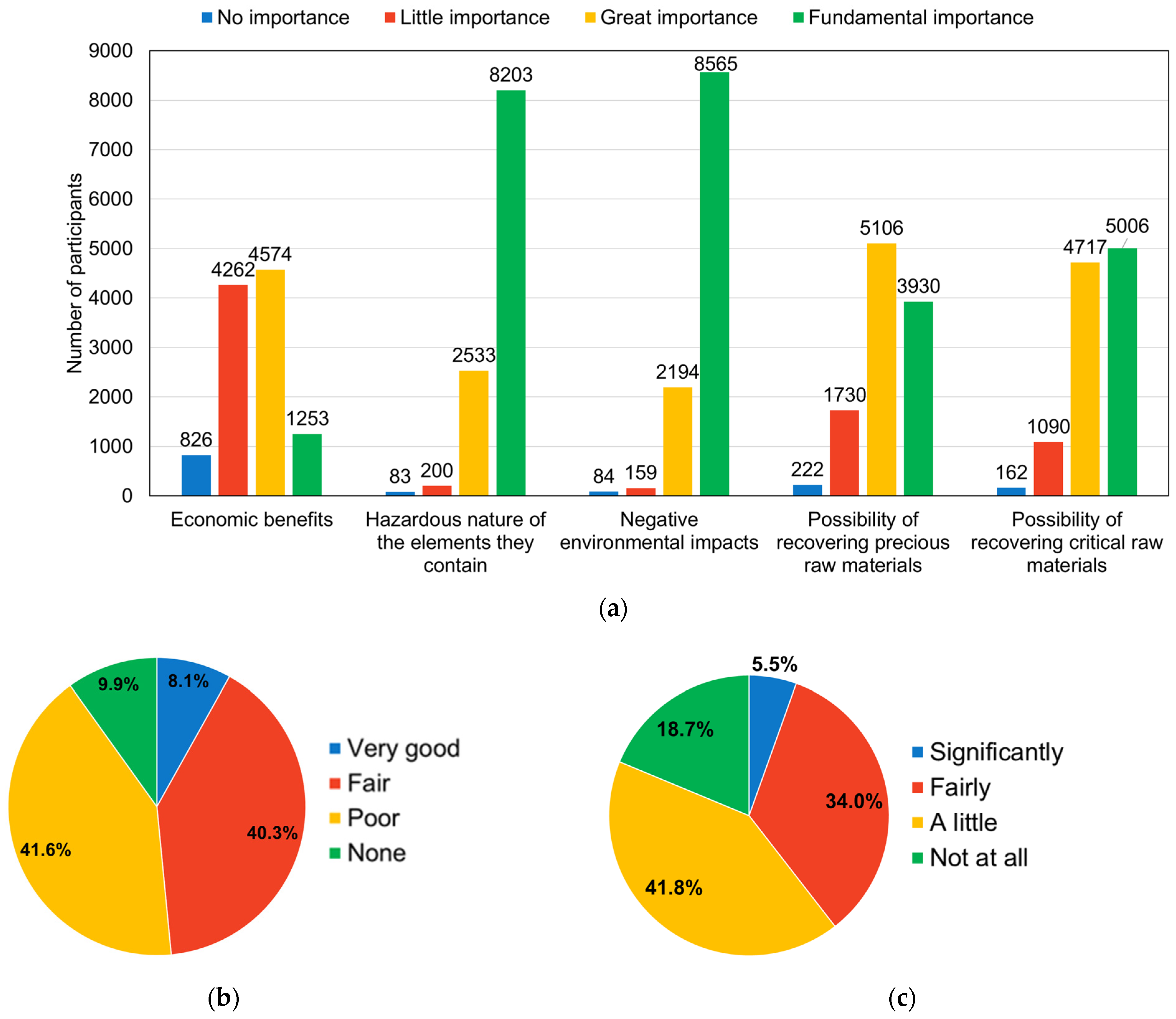
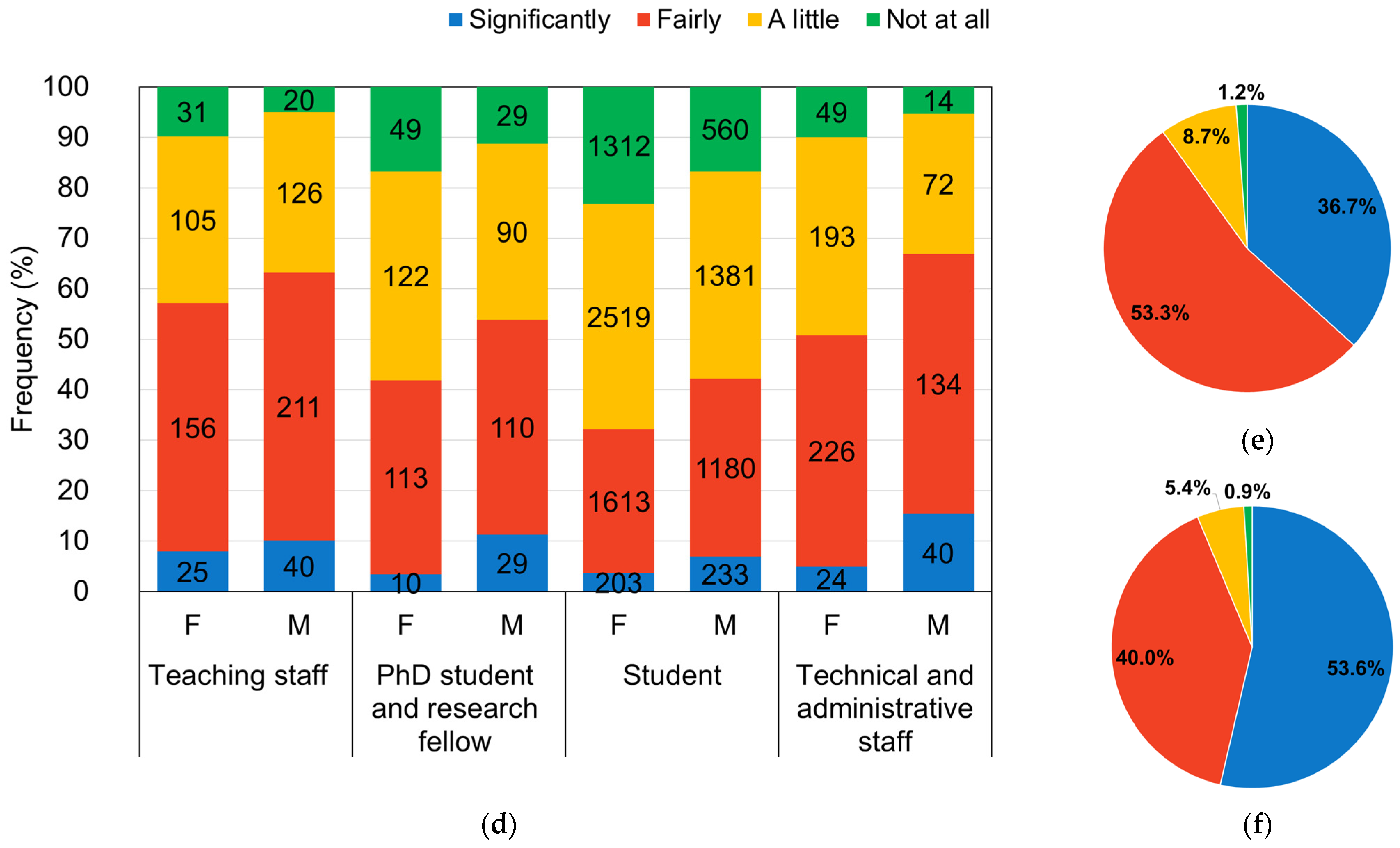
| Gender | n | % |
| Female | 6821 | 61.29 |
| Male | 4308 | 38.71 |
| NA | 34 | 0.30 |
| Tot. | 11,163 | 100 |
| Age [Years] | n | % |
| <20 | 608 | 5.45 |
| 20–29 | 7724 | 69.33 |
| 30–39 | 1022 | 9.16 |
| 40–49 | 599 | 5.37 |
| 50–59 | 700 | 6.27 |
| 60–70 | 417 | 3.74 |
| >70 | 48 | 0.44 |
| NA | 27 | 0.24 |
| Tot. | 11,136 | 100.00 |
| Role | n | % |
| Teaching staff | 718 | 6.47 |
| Full professor | 133 | 1.20 |
| Assistant professor | 148 | 1.33 |
| Associate professor | 287 | 2.59 |
| Adjunct professor | 87 | 0.78 |
| Fixed-term researcher type A | 38 | 0.34 |
| Fixed-term researcher type B | 25 | 0.23 |
| PhD student and research fellow | 553 | 4.98 |
| PhD student and medical resident | 370 | 3.33 |
| Collaborator | 60 | 0.54 |
| Research fellow | 99 | 0.89 |
| Research grant holder | 24 | 0.22 |
| Student | 9069 | 81.73 |
| Technical and administrative staff | 756 | 6.81 |
| Technical and administrative staff (non-Managerial Staff) | 727 | 6.55 |
| Manager | 29 | 0.26 |
| Tot. | 11,096 | 100.00 |
| Category | Key Findings | Statistical Notes | Comparison with the Literature |
|---|---|---|---|
| Phone ownership | 90.6% own one phone | Descriptive statistics | Similar trends observed in Portugal [30] |
| Males more likely to own >1 phone | Chi-square test, p < 0.001 | ||
| Replacement frequency | 48.8% replace every 3–5 years; 36.7% every 1–3 years | Descriptive statistics | Similar findings in [24,31] |
| Students replace more often | Chi-square test, p < 0.001 | Similar findings in [24,35,36] | |
| Reasons for replacement | 54% due to damage, 46% due to high repair cost; only 20.2% wait until irreparable. | Descriptive statistics | Similar findings in [24,29,30,37] |
| Females more likely to replace due to damage than males | Chi-square test, p < 0.05 | Novel insights | |
| Conditions at replacement | 20.2% irreparable, 23.1% still functioning, 46.0% repairable at higher cost, broken but repairable 10.7% | Descriptive statistics | Similar findings in [24,37] |
| Females more likely to replace when irreparable than males, males more likely when it is still functioning | Chi-square test, p < 0.05 | Similar findings in [30] | |
| Handling of unused MBs | 47.3% keep at home, 17.2% keep for potential spare parts, 11.7% donate, only 9.8% recycle | Descriptive statistics | Similar findings in [6,29,38,39,40] |
| Students more likely to keep for spare parts or to resell than staff categories and less likely to take to the recycling center or retailer | Chi-square test, p < 0.05 | Novel insights | |
| Urban mine estimate | 92.3% store at least one old phone at home | Descriptive statistics | Novel insights |
| Students more likely to keep more than one discarded MP than other roles | Chi-square test, p < 0.05 | Novel insights | |
| Estimated 29,799 unused phones stored | Extrapolated from survey responses | Novel insights | |
| Awareness: hazardous components | 92.6% aware | Descriptive statistics | Novel insights |
| Males more aware than females | Chi-square test, p < 0.001 | Similar findings in [30] | |
| Awareness: precious and rare metals | 65.2% aware | Descriptive statistics | Similar findings in [8] |
| Males more aware than females | Chi-square test, p < 0.05 | Novel insights | |
| STEEM students more informed than HASS and Medicine students | Chi-square test, p < 0.05 | Novel insights | |
| Awareness of critical raw materials | 74.3% unaware MPs contain CRMs, 90.9% unaware of EU CRM list, 73.6% do not know Coltan | Descriptive statistics | Novel insights |
| Awareness: take-back programs | 73.3% unaware of “One-for-One”; 88.3% unaware of “One-for-Zero” | Descriptive statistics | Low take-back awareness compared to other countries [24,30,40,43] |
| Younger groups less aware | Chi-square test, p < 0.001 | Similar findings in [44,45] | |
| Self-assessment WEEE knowledge | 41.5% poor, 40.3% fair, only 8.1% very good | Descriptive statistics | Novel insights |
| Students and females perceived themselves as being less informed | Chi-square test, p < 0.05 | Novel insights | |
| Educational impact of survey | 90% reported increased awareness after the survey | Descriptive statistics | Novel insights |
| Support for collection system | 93.1% support implementation of on-campus WEEE collection system | Descriptive statistics | Novel insights |
| Section | Questions |
|---|---|
| Section 1. General Information (GI) | GI01. Please choose your gender (Multiple choice with single answer) GI02. Please choose your age (Multiple choice with single answer) GI03. Please choose your current position (role) at the University (Multiple choice with single answer) GI04. If you are a staff member, which is the structure you belong to? (Multiple choice with single answer) GI05. If you are a student, what is your Faculty of affiliation? (Multiple choice with single answer) GI06. If you are a student, which is your program? (Multiple choice with single answer) GI07. If you are a student, which is your program year? (Multiple choice with single answer) |
| Section 2. Habits and Behaviors (HB) towards EoL mobile phones management | HB01. How many mobile phones do you own? (Multiple choice with single answer) HB02. How often do you replace your mobile phone? (Multiple choice with single answer) HB03. What reasons lead you or would lead you to buy a new mobile phone to replace the previous one? (Multiple choice with single answer) HB04. What condition is your mobile phone in when you decide to replace it? (Multiple choice with single answer) HB05. What do you do (or would you do) with a mobile phone you no longer use? (Multiple choice with single answer) HB06. How many discarded mobile phones do you keep at home? Indicate a number (e.g., 0, 1, 2, etc.). (Open-ended answer) |
| Section 3. Knowledge and Awareness (KA) about EoL mobile phones management | KA01. Do you know that mobile phones contain hazardous elements for the health and the environment? (Yes/No answer) KA02. Do you know that, if not properly disposed of, mobile phones can release hazardous elements such as lead, bromine, chromium, arsenic and antimony? (Yes/No answer) KA03. Do you know that mobile phones contain precious and rare metals such as silver, gold, platinum and rare earths? (Yes/No answer) KA04. Do you know that the concentrations of copper, gold, silver and other strategic chemical elements present in mobile phones are much higher than those found in a mineral deposit?” (Yes/No answer) KA05. Critical raw materials (CRMs) are identified by the European Commission based on two factors: economic importance and supply risk for European industry. Do you know that there are currently 27 * critical raw materials identified by the European Union? (Yes/No answer) KA06. Do you know that critical raw materials such as rare earths, tantalum and indium are used in the manufacturing of mobile phones? (Yes/No answer) KA07. Are you aware of the existence of a particular strategic raw material, called Coltan, mainly extracted in Congo, that is used in the construction of mobile phones? (Yes/No answer) KA08. Do you know that the acronym WEEE stands for Waste from Electrical and Electronic Equipment? (Yes/No answer) KA09a: “One-for-one operation. Since June 2010, there has been a ‘one-for-one’ WEEE take-back obligation: sellers of electrical and electronic equipment are required to take back WEEE free of charge when the customer purchases a new equivalent product. Were you aware of this?” (Yes/No answer) KO09b: “How many times have you used this service?” (Multiple choice with single answer) KA10a: “One-for-Zero Operation. Since April 2014, the ‘one-for-zero’ take-back obligation has also been introduced: stores selling electrical and electronic equipment with a sales area larger than 400 square meters are required to accept ‘very small WEEE’ (maximum size 25 cm) free of charge, even when the customer does not purchase a new product. Were you aware of this service?” (Yes/No answer) KA10b: “How do you rate this service?” (Multiple choice with single answer) |
| Section 4. Opinions and Conclusions (OC) | OC01. In your opinion, why is the separate collection of this type of waste important? (Multiple choice with single answer for 5 different motivations: 4-level scale from “No importance” to “Fundamental importance”) OC02. What do you consider to be your level of knowledge regarding the proper disposal of mobile phones? (Multiple choice with single answer: 4-level scale from none to very good) OC03. How much do you think you are a responsible and generally informed consum-er/user regarding WEEE? (Multiple choice with single answer: 4-level scale from “not at all” to “significantly”) OC04. How much do you think this questionnaire has helped you to increase your knowledge and awareness about WEEE in general? (Multiple choice with single answer: 4-level scale from “not at all” to “significantly”) OC05. Do you think it is important to share this knowledge and information with your colleagues, friends and family? (Multiple choice with single answer: 4-level scale from “not at all” to “significantly”) OC06. If there were a collection system for small WEEE at Sapienza, would you use it? (Yes/No answer) |
Disclaimer/Publisher’s Note: The statements, opinions and data contained in all publications are solely those of the individual author(s) and contributor(s) and not of MDPI and/or the editor(s). MDPI and/or the editor(s) disclaim responsibility for any injury to people or property resulting from any ideas, methods, instructions or products referred to in the content. |
© 2025 by the authors. Licensee MDPI, Basel, Switzerland. This article is an open access article distributed under the terms and conditions of the Creative Commons Attribution (CC BY) license (https://creativecommons.org/licenses/by/4.0/).
Share and Cite
Serranti, S.; Gasbarrone, R.; Palmieri, R.; Bonifazi, G. Sustainable Mobile Phone Waste Management: Behavioral Insights and Educational Interventions Through a University-Wide Survey. Recycling 2025, 10, 129. https://doi.org/10.3390/recycling10040129
Serranti S, Gasbarrone R, Palmieri R, Bonifazi G. Sustainable Mobile Phone Waste Management: Behavioral Insights and Educational Interventions Through a University-Wide Survey. Recycling. 2025; 10(4):129. https://doi.org/10.3390/recycling10040129
Chicago/Turabian StyleSerranti, Silvia, Riccardo Gasbarrone, Roberta Palmieri, and Giuseppe Bonifazi. 2025. "Sustainable Mobile Phone Waste Management: Behavioral Insights and Educational Interventions Through a University-Wide Survey" Recycling 10, no. 4: 129. https://doi.org/10.3390/recycling10040129
APA StyleSerranti, S., Gasbarrone, R., Palmieri, R., & Bonifazi, G. (2025). Sustainable Mobile Phone Waste Management: Behavioral Insights and Educational Interventions Through a University-Wide Survey. Recycling, 10(4), 129. https://doi.org/10.3390/recycling10040129








